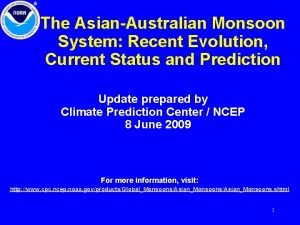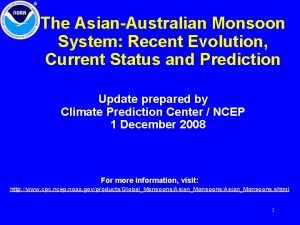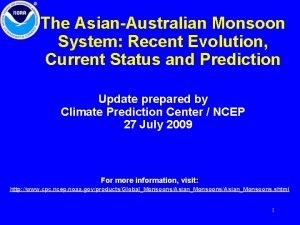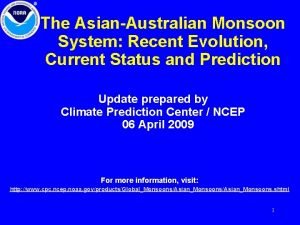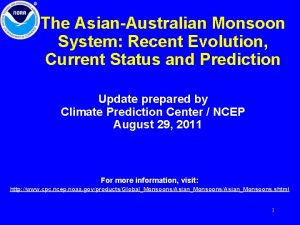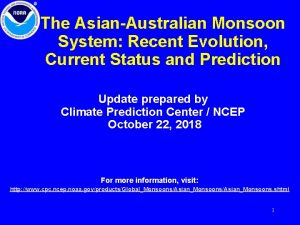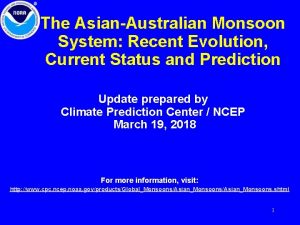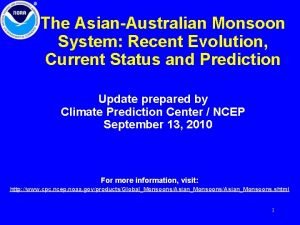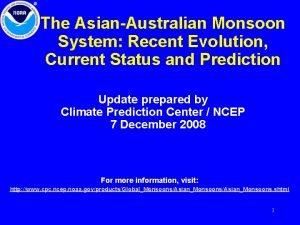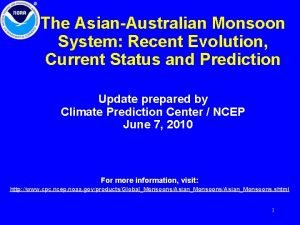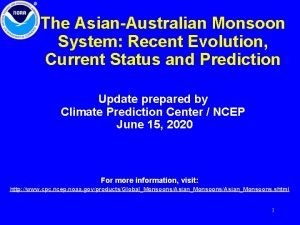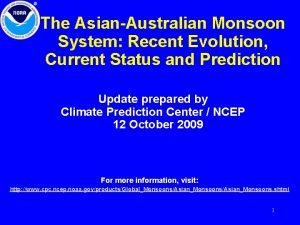The AsianAustralian Monsoon System Recent Evolution Current Status













- Slides: 13

The Asian-Australian Monsoon System: Recent Evolution, Current Status and Prediction Update prepared by Climate Prediction Center / NCEP May 3, 2010 For more information, visit: http: //www. cpc. ncep. noaa. gov/products/Global_Monsoons/Asian_Monsoons. shtml 1

Outline • Recent Evolution and Current Conditions • Monsoon Prediction • Summary • Climatology 2

Precip Patterns: Last 90 Days During the past 90 days, precipitation over the Middle East, southern Asia, Southeast Asia, northwestern Pacific, Madagascar, subtropical-central southern Indian Ocean, subtropical-eastern southern Indian Ocean, and western Australia was mainly below average. Above-average precipitation was observed over equatorial eastern Indian Ocean, part of tropical southern Indian Ocean, eastern Australia, Bangladesh, East Asia, and extratropical northwestern Pacific. 3

Precip Patterns: Last 30 Days During the past 30 days, above-average precipitation was seen over Bangladesh, East Asia, northwestern Pacific storm-track region, equatorial Southeast Asia, northern Australia, southeastern Indian Ocean off Indonesia, and equatorial western Pacific. Below-average precipitation was observed over much of southern Asia, subtropical northwestern Pacific, Madagascar, and tropical-subtropical southern Indian Ocean. 4

Precip Patterns: Last 5 Days Precipitation was mainly near normal over the Asian-Australian region. Aboveaverage rainfall was observed over the waters southeast of Japan and belowaverage rainfall was seen over eastern China, tropical southern Indian Ocean, and tropical western Pacific Ocean. 5

Rainfall Time Series over 5 x 5 lat-lon boxes *This unified land-only daily precipitation dataset is different from the CMAP dataset used in the previous three spatial maps. Upper panel: The precipitation over East Asia including eastern China, Korea, and southern Japan has been mostly above average. Middle panel: The dry condition over southwestern China has been improving. Lower panel: The pre-monsoon rainfall over much of East Asia has been moderately above average. 6

Atmospheric Circulation Strong cross-equatorial flow was observed over the central Indian Ocean. An anomalous anticyclonic pattern appeared over the Bay of Bengal and anomalous northerly flow occurred over eastern China and the South China Sea. 7

NCEP/GFS Model Forecasts Bias-Corrected Precip. Anom. for Weak 1 & Week 2 Week-1 Week-2 8

Prediction of Large-Scale Monsoon Circulation Upper panel: Webster-Yang monsoon index (Webster and Yang 1992) defined as U 850 (020ºN, 40 -110ºE) – U 200 (0 -20ºN, 40 -110ºE). Positive (negative) values indicate strong (weak) than normal monsoon. The NCEP Global Forecast System predicts that the large-scale monsoon circulation over tropical Asia, which has been weaker than normal, will become stronger in the next two weeks. Lower panel: Correlation between rainfall and Webster-Yang monsoon index (Webster and Yang 1992; shading) and regression of 850 -mb winds on the monsoon index (vectors) for May. Green (brown) shading indicates increase (decrease) in rainfall associated with strong monsoon. 9

Prediction of East Asia – NW Pacific Monsoon Upper panel: East Asia – Western North Pacific (EAWNP) monsoon index (Wang et al. 2008) defined as U 850 (5 -15ºN, 40 -80ºE) – U 850 (20 -30ºN, 70 -90ºE). Positive (negative) values indicate strong (weak) than normal monsoon. The NCEP Global Forecast System predicts that, in the next two weeks, the monsoon circulation over Southeast Asia and northwestern Pacific will be near or weaker than normal. Lower panel: Correlation between rainfall and East Asia – Western North Pacific monsoon index (Wang et al. 2008; shading) and regression of 850 -mb winds on the monsoon index (vectors) for May. Green (brown) shading indicates increase (decrease) in rainfall associated with strong monsoon. 10

Summary • Precipitation was mainly near normal over the Asian-Australian region. Above-average rainfall was observed over the waters southeast of Japan and below-average rainfall was seen over eastern China, tropical southern Indian Ocean, and tropical western Pacific Ocean. • The NCEP Global Forecast System predicts that, in the next two weeks, the monsoon circulation over Southeast Asia and northwestern Pacific will be near than normal. 11

Onset of the Asian Monsoon 12

Climatology 13
 Y connected generator
Y connected generator Difference between phase voltage and line voltage
Difference between phase voltage and line voltage N=nc exp(-eg/2kt)
N=nc exp(-eg/2kt) Lesson 4 three-phase motors
Lesson 4 three-phase motors Drift current
Drift current Drift current and diffusion current in semiconductor
Drift current and diffusion current in semiconductor The constant-current area of a fet lies between
The constant-current area of a fet lies between Balanced delta-delta connection
Balanced delta-delta connection Holding current and latching current
Holding current and latching current Diffusion current formula
Diffusion current formula In alternators the welding current is produced on the
In alternators the welding current is produced on the Hazard based safety engineering
Hazard based safety engineering Mesh current method with current source
Mesh current method with current source Current program status register is
Current program status register is














